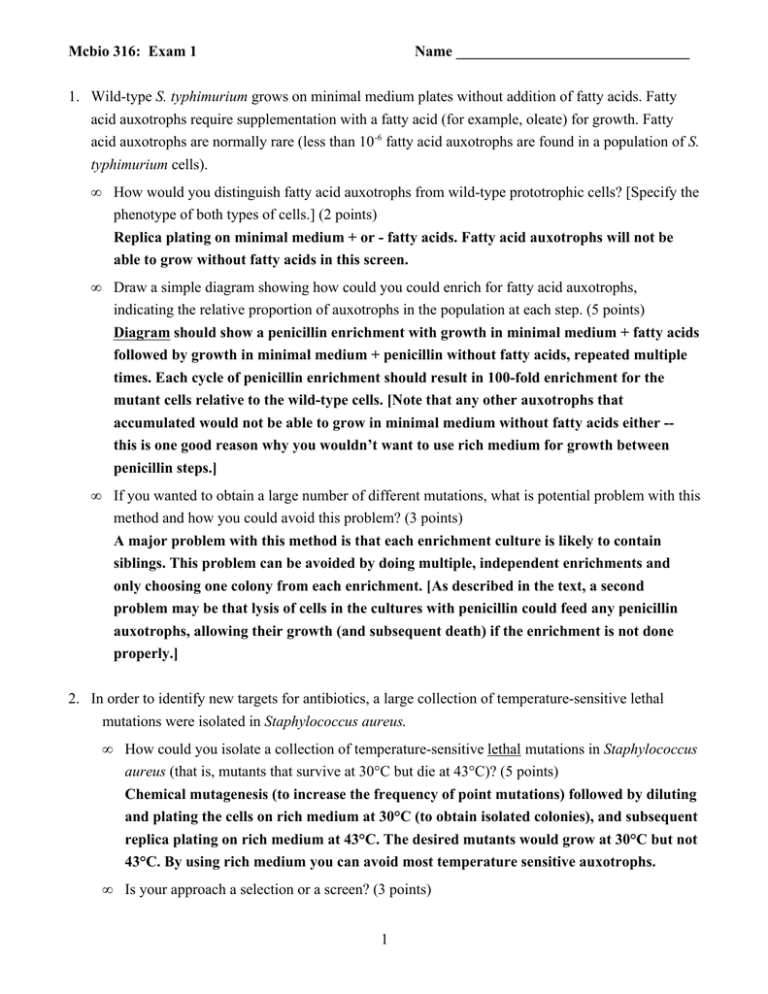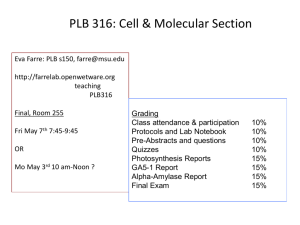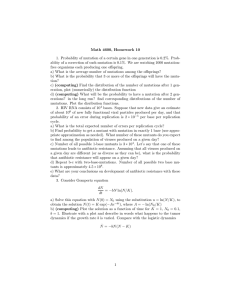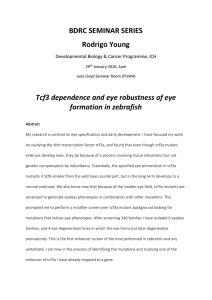Exam 1
advertisement

Mcbio 316: Exam 1 Name _______________________________ 1. Wild-type S. typhimurium grows on minimal medium plates without addition of fatty acids. Fatty acid auxotrophs require supplementation with a fatty acid (for example, oleate) for growth. Fatty acid auxotrophs are normally rare (less than 10 -6 fatty acid auxotrophs are found in a population of S. typhimurium cells). • How would you distinguish fatty acid auxotrophs from wild-type prototrophic cells? [Specify the phenotype of both types of cells.] (2 points) Replica plating on minimal medium + or - fatty acids. Fatty acid auxotrophs will not be able to grow without fatty acids in this screen. • Draw a simple diagram showing how could you could enrich for fatty acid auxotrophs, indicating the relative proportion of auxotrophs in the population at each step. (5 points) Diagram should show a penicillin enrichment with growth in minimal medium + fatty acids followed by growth in minimal medium + penicillin without fatty acids, repeated multiple times. Each cycle of penicillin enrichment should result in 100-fold enrichment for the mutant cells relative to the wild-type cells. [Note that any other auxotrophs that accumulated would not be able to grow in minimal medium without fatty acids either -this is one good reason why you wouldn’t want to use rich medium for growth between penicillin steps.] • If you wanted to obtain a large number of different mutations, what is potential problem with this method and how you could avoid this problem? (3 points) A major problem with this method is that each enrichment culture is likely to contain siblings. This problem can be avoided by doing multiple, independent enrichments and only choosing one colony from each enrichment. [As described in the text, a second problem may be that lysis of cells in the cultures with penicillin could feed any penicillin auxotrophs, allowing their growth (and subsequent death) if the enrichment is not done properly.] 2. In order to identify new targets for antibiotics, a large collection of temperature-sensitive lethal mutations were isolated in Staphylococcus aureus. • How could you isolate a collection of temperature-sensitive lethal mutations in Staphylococcus aureus (that is, mutants that survive at 30°C but die at 43°C)? (5 points) Chemical mutagenesis (to increase the frequency of point mutations) followed by diluting and plating the cells on rich medium at 30°C (to obtain isolated colonies), and subsequent replica plating on rich medium at 43°C. The desired mutants would grow at 30°C but not 43°C. By using rich medium you can avoid most temperature sensitive auxotrophs. • Is your approach a selection or a screen? (3 points) 1 Mcbio 316: Exam 1 Name _______________________________ A screen. [The mutants die at 43°C -- you would have to look through many replica plates to find the desired temperature sensitive mutants.] • Why might temperature-sensitive lethal mutants identify useful targets for antibiotics. (2 points) Temperature sensitive lethal mutations define essential genes -- that is, genes whose products are required for the bacteria to reproduce. Once you have identified such essential genes, you may be able to design an antibiotic that disrupts the target gene product and would thus prevent the bacteria from multiplying. [Note the purpose of an antibiotic is to prevent growth of bacteria in nature (i.e. wild-type bacteria), not just some mutant that is not likely to infect anyone other than a careless lab worker! ] 3. When grown on MacConkey-Lactose indicator plates, Lac+ strains of E. coli form red colonies and Lac- strains of E. coli form white colonies. • How could you directly screen for strains with a mutator phenotype using MacConkey-Lactose plates? (4 points) Begin with a Lac- culture. Mutagenize the culture, then dilute it and plate the dilutions on Mac-Lac plates (to obtain isolated colonies). Non-mutator strains will have white colonies because typical reversion frequencies are <10-7 and a typical colony contains about 106 cells. In contrast, the mutation frequency in mutator strains is often increased about 100-fold, so within a colony of a mutator strain Lac+ (red) papilli (“microcolonies”) will appear. Assuming that you can screen 200 isolated colonies per plate (a conservative number), and that following mutagenesis about 1/1000 cells will have a mutation in a gene that leads to a mutator phenotype, this screen is relatively easy and can be done with a minimal number of plates. Also, you are extremely unlikely to find this colony phenotype by simple mutations in the lac genes. [An event more likely to cause the entire colony to change colors on the Mac-Lac plate. Think about this problem: if you found a colony that changed from a Lac- to a Lac+ phenotype (or vice versa depending upon the starting strain), how would you determine whether it had a mutator phenotype?] Note that this question was included in the supplemental questions with Homework # 2. • Use a specific example to describe the molecular basis for a mutator phenotype. (3 points) Two examples we discussed in class are dnaQ (or mutD) and mutSLH. Your answer should describe how a mutation in one of these genes increases the overall mutation frequency of the mutant cell. 4. Several E. coli mutations were isolated that produce a Lac- phenotype when present on the chromosome. The lac operon has three gene products that can be assayed independently. 2 Mcbio 316: Exam 1 Name _______________________________ Complementation analysis was done with each of the new lac mutations on multicopy plasmids and known lac mutations on the chromosome. The results are shown in the following table. Based upon the results, indicate which gene the mutation affects and explain your conclusion. (10 points for table) Plasmid Chromosome lacZ lacY lacA Mutant Gene or Genes? Explanation (a) lac-9001 + − + lacY Cannot complement a lacY mutant but can complement lacZ and lacA mutants (b) lac-9002 + + − lacA Cannot complement a lacA mutant but can complement lacZ and lacY mutants (c) lac-9003 − + + lacZ Cannot complement a lacZ mutant but can complement lacY and lacA mutants (d) lac-9004 − − − lac Z, Y, A Cannot complement a lacY, lacZ, or lacA mutants (e) lac-9005 + + + Unknown ComplementslacZ, lacY, and lacA mutants -- the three known genes in the lac operon • Assuming that all the results described are valid and that no mutations outside of the lac operon are required for lactose utilization, what could cause the results observed for lac-9005 in row (e)? (3 points) The lac-9005 mutation is known to have a Lac - phenotype when present on the chromosome. The simplest explanation for this complementation result is that the lac-9005 mutation results in overproduction suppression when present on a multicopy plasmid. [An alternative possibility is that the mutation affects some unknown gene that affects some new gene that results in a Lac- phenotype -- the statement “the lac operon has three genes ...” was the clue that there really are only three specific, structural genes that are required for lactose catabolism. • How could you test your hypothesis? (2 points) A simple test for overproduction suppression is to do the complementation analysis with a single copy of each lac mutant. 5. Both supD and supE mutants are efficient amber suppressors. 3 Mcbio 316: Exam 1 • Name _______________________________ When a supD mutation is moved into a strain with the lac-9004 mutation, the phenotype becomes Lac+ . Based upon this observation, explain why the lac-9004 mutation is unable to complement lacZ, lacY, or lacA mutants. (6 points) lac-9004 is due to an amber codon (UAG) in the first gene of the lac operon. The inability to complement the other two lac genes is due to polarity caused by rho-dependent termination -- when translation is terminated at the amber stop codon, rho terminates transcription, preventing expression of downstream genes. [rho-dependent polarity is described in the supplement on the 316 Web site -- this is one of the sites I recommended you read.] Although you may know that the lacZ gene is the first gene in the operon, from the data given you cannot tell the gene order. [Note that the amber mutation cannot lie in the untranslated region upstream of the first gene -- think about why!] • When a supE mutation is moved into a strain with the lac-9004 mutation, the phenotype remains Lac-. Suggest a potential reason for the difference between the suppression by supE and supD. (3 points) supD inserts a different amino acid from supE. Thus, both amber suppressors would prevent the polarity on downstream genes. The amino acid inserted by supD is tolerated in the resulting protein, resulting in a functional gene product. However, the amino acid inserted by supE is probably not tolerated, so no functional gene product in formed. Because the gene product is required for the Lac + phenotype, the supE strain will remain Lac-. [Note that this was just like a supplemental question on Homework #3.] 6. Succinate dehydrogenase (sdh) catalyzes the conversion of succinate to fumerate under aerobic conditions, and fumerate reductase (fdr) catalyzes the conversion of fumerate to succinate under anaerobic conditions. Mutants defective for succinate dehydrogenase are unable to use succinate as a carbon source. It is possible to isolate suppressors of a sdh mutant that allow growth on succinate as a carbon source aerobically. Describe 6 different types of suppressors that might be obtained and describe how each suppressor would restore the sdh+ phenotype. [Use the back of this page if needed.] (12 points) [Note that this question was very similar to a one-minute write question and a question on one of the sample exams.] Some examples include the following: (i) Informational suppressor -- e.g. a missense suppressor tRNA which would occasionally misread the sdh mRNA and produce a functional protein. (ii) An allele specific, intragenic interaction suppressor with a mutation at a second site in the sdh gene that restores the structure and function of the Sdh protein. (iii) A non-allele specific, intragenic suppressor with a mutation at a second site in the sdh gene that increases the stability or activity of the Sdh protein. 4 Mcbio 316: Exam 1 Name _______________________________ (iv) An allele specific, interaction suppressor in another protein that interacts with the Sdh protein that restores the structure and function of the Sdh protein. (v) A bypass suppressor -- e.g. a mutation that allows the fdh gene product to catalyze the synthesis of succinate under aerobic conditions. [Such mutations were actually found using this approach.] (vi) An overexpression suppressor that increases the amount of the mutant Sdh protein to sufficient levels that it allows cell growth. (vii) A true revertant that restores the wild-type sdh DNA sequence. 7. Mutagenesis with UV light causes a variety of types of mutations, but the mutagen ICR181 specifically causes frameshift mutations. A large number of Klebsiella aerogenes putP mutations were obtained with both mutagens. About 5% of the putP mutants obtained following UV mutagenesis had detectable CRM, while none of the mutants obtained following ICR181 mutagenesis had detectable CRM. • What does the presence of CRM indicate? (3 points) The presence of cross-reacting material suggests that the mutant phenotype is caused by a missense mutation (i.e. the protein is made and can be detected by antibodies but it is inactive). • Suggest a likely explanation for these results. (3 points) Frameshift mutations cause premature termination of putP and the truncated polypeptide is rapidly degraded by cellular proteases (hence no CRM). In contrast, a small percentage of the mutations that arise spontaneously are base substitution mutations that result in missense mutations (hence are CRM +). • Given the sequence of the beginning of the putP gene shown below, indicate a potential hot spot for frameshift mutations. (3 points) Any run of identical base pairs. A few examples are highlighted below. ATGGCTATTAGCACACCGATGTTGGTGACATTCTGTGTCTATATTTTTGGCATGATATTGATTGGGTTT ATCGCCTGGCGCTCAACCAAAAACTTTGATGACTATATTCTTGGCGGTCGCAGTCTGGGGCCGTTTGTT ACGGCTTTATCAGCCGGCGCGTCGGATATGAGCGGCTGGCTGTTAATGGGGCTGCCTGGCGCTATCTTT CTGTCGGGGATCTCTGAAAGCTGGATCGCCATTGGCCTGACGTTAGGCGCATGGATTAACTGGAAGCTG GTGGCCGGGCGCCTGCGCGTGCATACCGAATTTAACAATAACGCGCTCACGCTGCCGGACTATTTTACC GGTCGGTTTGAGGATAAGAGCCGAGTCCTGCGTATTATTTCCGCGCTGGTCATTCTGTTGTTTTTCACT 5 Mcbio 316: Exam 1 Name _______________________________ 8. Several dozen new proline auxotrophs were isolated in E. coli and they all fell into three complementation groups. • What does this result suggest? (2 points) Three genes involved in proline biosynthesis have been identified. • To determine the order of the biosynthetic steps affected in the pro mutants, a representative mutant from each complementation group was tested for crossfeeding. What medium would you use for this experiment? [Explain why.] (2 points) Minimal medium without proline (or supplemented with a tiny concentration of proline). [If you used rich medium or added proline, all the mutants would grow so you would be unable to see if cross-feeding occurred.] • The results obtained are shown below. Based upon these results, what is the order of the gene products in the proline biosynthetic pathway. (3 points) pro-117 pro-116 pro-118 Note that a mutant defective later in the pathway will crossfeed mutants that affect earlier steps in the pathway. Thus the order is: 117 - 118 - 116. 9. What is the difference between mutation rate and mutant frequency? [Give a general description of what experiments you would need to do to determine the two values.] (6 points) The mutation rate is the number of mutations per cell division. Because the cell population is so large, the number of cell divisions is approximately equal to the number of cells in the population (N). h a= N The value of h can be determined by a fluctuation test. The mutant frequency is simply the ratio of mutants / total cells in the population. This can be determined by simply plating out aliquots of a culture and counting the number of mutants that arise and the number of cells plated. The mutant frequency is much easier to measure but 6 Mcbio 316: Exam 1 Name _______________________________ may show large fluctuations depending upon when the first mutation appeared in the population. 10. In the following table, briefly diagram or indicate the common properties of each type of mutation. (1 point for each box) Mutation Missense Nonsense Frameshift Deletion Insertion effect on DNA base substitution base substitution resulting in a stop codon insertion or loss of deletion of 1 multiple base or 2 base pairs pairs addition of multiple base pairs effect on Protein substituted amino acid truncated polypeptide; inactive protein altered amino acid sequence downstream of mutation; usually truncated polypeptide; inactive protein usually absent; usually inactive protein may insert extra amino acid (if in frame) or cause premature truncation; usually inactive protein may result in loss of function or conditional phenotype usually null null null usually null; if insertion is in frame and doesn’t cause premature termination and is in a permissive site, sometimes protein remains functional effect on Phenotype 7





